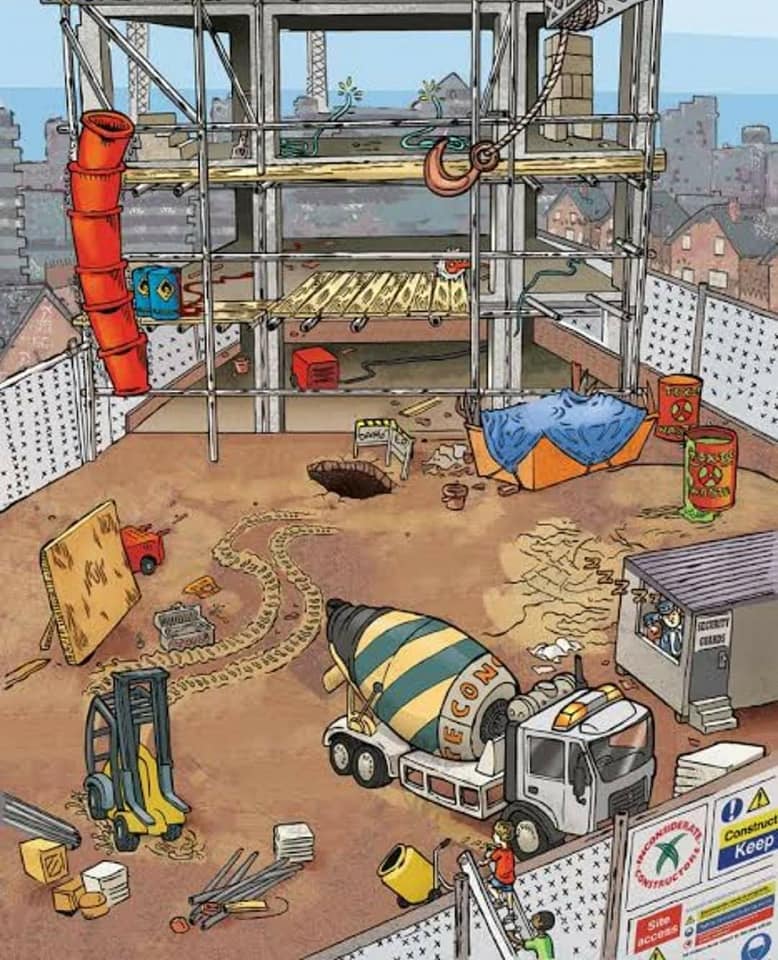Photo of the day: Unsafe Conditions
Unsafe conditions are hazards that have the potential to cause injury or death to an employee. Some of these hazards include erroneous safety procedures, malfunctioning equipment or tools, or failure to utilize necessary safety equipment such as goggles and masks. Unsafe conditions can be found in a variety of workplaces, but they pose a special hazard to workers in industrial, manufacturing, or manual labor positions. At the time of hire, companies should provide workers with the information and training they need in order to avoid unsafe conditions. If a single employee engages in unsafe acts, other employees who work in the same environment will be exposed to unsafe conditions.
In the picture below try to find out all Unsafe conditions and share your recommendations about corrective Actions


7 examples of unsafe working conditions
Every day, workers are exposed to unsafe conditions on the job. Many of them suffer moderate to serious injuries. Others are killed. Occupational hazards abound, even though many steps have been taken to eliminate them.
To help you know what to watch out for, here are seven examples of unsafe working conditions:
- Defective equipment: This could include tools and supplies that are defective when they come from the factory or have worn out over time and have never been repaired or replaced.
- Inadequate guards: Many tools are inherently dangerous, and guards must be in place to keep workers from harm.
- Fire hazards: In some cases, there is even the risk of a serious explosion.
- Workplace congestion: As the company grows, the workspace needs to grow with it.
- Inadequate or broken warning systems: Workers may not even realize there is a significant risk of injury until it is too late.
- Hazardous air conditions: Workers come away with respiratory issues and other workplace diseases after being forced to breathe this contaminated air for shift after shift.
- Lack of cleaning and poor housekeeping: When the workplace is dirty and cluttered, injuries are more likely. For instance, workers could trip on extension cords that were not put away properly or they could slip and fall on staircases that have never been cleaned.
Addressing Unsafe Conditions
Depending on what the unsafe condition is will determine what action is needed to correct it. A basic overview of addressing any hazard in the workplace:
- Stop and take the time to evaluate your work area and work task.
- Recognize unsafe conditions or what can possibly turn into one.
- Take action to immediately correct the condition if possible.
- Stop work and involve the other person if the situation requires you to do so.
- Follow through to ensure any hazards you identified are properly mitigated.
- Continue to evaluate your work area throughout the workday for possible new hazards.
Summary
Unsafe conditions do exist all around us and it is true that not every single possible hazard in life can be eliminated. However, we all can take ownership and responsibility for the work that we do to eliminate the ones we identify. Every unsafe condition that is corrected results in a lesser risk of someone being injured on the job.
Download the photo
More photos:
- Photo of the day: Identify the Hazards
- Photo of the day: Hand safety Facts
- Photo of the day: What are the hazards
- Photo of the day: Outline Safety observations
- Photo of the day: Safety Leader
- Photo of the day: Unsafe Conditions
- Photo of the day: Why is PPE important?
- Photo of the day: DO’S and DON’TS of Working At Heights
- Photo of the day: 5 Tips to keep your Crew Healthy and safe at work
- Photo of the day: Tracking Near Miss Incidents
- Photo of the day: 10 Elements of Successful Behavior-Based Safety Program
- Photo of the day:5-Signs your Near-Miss Reporting is failing
- Photo of the day:7 Ineffective Safety Practices (And What To Do Instead)
- Photo of the day:5 keys for effective Self-Management in lone worker safety
- Photo of the day: FrontLine supervisors are the LINCHPINS of safety
- Photo of the day: Fostering Engagement at the front line
- Photo of the day: workplace Hazards
- Photo of the day: What is the line of fire
- Photo of the day: How to Avoid the Fatal Four
- Photo of the day: Fire Safety checklist for workplace
- Photo of the day: Most common safety incidents in the workplace
- Photo of the day: Fire Emergency
- Photo of the day: Ladder Safety Tips
- Photo of the day: 8 Basic steps to wear a safety harness
- Photo of the day: You can prevent workplace Falls
- Photo of the day: Top10 Injuries in office work
- Photo of the day: Overhead powerline safety
- Photo of the day: Eyes on the Road The challenges of safe driving
- Photo of the day: 5 Ways to Reinforce Commuting With Positive Reinforcement
- Photo of the day: Safe Lifting at work
- Photo of the day: 5 Essential outcomes of an effective leadership survey process
- Photo of the day: Conveyors Safety Tips
- Photo of the day: Confined Space rescue
- Photo of the day: Construction Site fire Safety
- Photo of the day: Chemical Spill Emergency Response
- Photo of the day: Electric shock survival
- Breath Safely: The Proper Use of Respiratory Protection
- Photo of the day: Confined space safety Precautions
- Photo of the day: Choosing the Right Face Mask and the difference between a respirator and face mask
- Photo of the day: Importance of Mock drill and Fire Action Emergency Procedure
- H2S Gas and how to handle its Emergency
- Your steps to chemical safety
- Photo of the day: hierarchy of controls
- Photo of the day: Tips to reduce Heat stress in the workplace
- Photo of the day: Safety Equipment for Confined Spaces
- Photo of the day: Dangerous Goods Classes
- Photo of the day: Trenching Safety Tips That Can Save a Life
- Photo of the day: Mental health in the workplace
- Photo of the day: Emergency preparedness in the workplace
- Photo of the day: musculoskeletal disorders
- Photo of the day: Workplace Inspection
- Photo of the day: New worker Orientation & Safety Orientation checklist
- Photo of the day: Effective Health and Safety Committees
- Photo of the day: 10 Scaffold Safety Essentials
- Photo of the day: Incident Investigations
- Photo of the day: Preventing the spread of contagious illness
- Photo of the day: 5 ways to reduce the risk of Slipping and Tripping
- Photo of the day: Sitting at work
- How to use Plate Clamps Safely: Safety Moment#34
- Photo of the day: working in heat and Humidex Rating
- Photo of the day: Don’t be Driven to Distraction
- Photo of the day: Fatigue at Work
- Photo of the day: Noise in the affected workplace
- Photo of the day: Indoor Air Quality
- Photo of the day: WHMIS 2015 – Pictograms
- Photo of the day: Personal Protective Equipment last resort
- Photo of the day: Manual Material handling
- Photo of the day: Controlling COVID-19 in the Workplace-Physical Barriers
- Photo of the day: Generator Safety
- Photo of the day: Position for safety and comfort-Safety Tips
- Photo of the day: Cannabis and Impairment in the Workplace
- Photo of the day: sun safety in the workplace
- Photo of the day: Top FIVE Heavy Equipment Construction Site Safety Tips
- Photo of the day: Work-Related Asthma
- Photo of the day: choosing the right Anchorage
- Photo of the day: Protect your Head
- Photo of the day: Extension Cord Safety Tips
- Photo of the day: Concrete Truck Driver Hand Signals
- Photo of the day: Safe use of ladders and step ladders
- Photo of the day: Arc-Fault Circuit Interrupters (AFCI)
- Photo of the day: HSE Bulletin Board
- Photo of the day: Scissor Lift Safety
- Photo of the day: Managing Risks of Exposure to Solvents in the workplace
- Photo of the day: Flagman and Traffic control
- Photo of the day: Run Project safely with Crane Hand Signals
- Photo of the day: Read All Labels Work safe
- Photo of the day: Flood Safety Tips
- Photo of the day: Fall Protection Plans
- Photo of the day: Lockout and Tagout Safety
- Photo of the day: Types of Hand Protection
- Photo of the day: Types of Foot Protection
- Photo of the day: Floor Marking
- Photo of the day: Overhead Power lines Clearance




No one to discover the unsafe conditions????